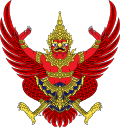| | |||||||||||||
| |||||||||||||
123 of the 246 seats in the House of Representatives | |||||||||||||
| Turnout | 38.95% ( | ||||||||||||
|---|---|---|---|---|---|---|---|---|---|---|---|---|---|
This lists parties that won seats. See the complete results below.
| |||||||||||||
General elections were held in Thailand on 26 February 1952 to elect half of the members of the House of Representatives. At the time there were no political parties, [1] so all candidates ran as independents. Voter turnout was 39%. [2]

